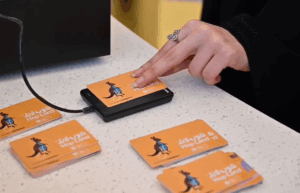In a world of increasingly immersive digital games, ThrowMotion’s Live Action Table Cricket game is an anomaly. Is this the future of real life gaming?
Live Action Table Cricket brings the realism of the gentleman’s game to the table top, combining accurately modelled physical play with digital and mobile technology. The game was invented by a rocket scientist and has bowled over staff at the offices of tech giants Google, Cisco, Juniper Networks and other companies in Silicon Valley.
.jpg) Blooloop spoke with Aditya Dayal (right), the inventor of Live Action Table Cricket and founder of ThrowMotion about his trajectory from astrophysicist to game designer.
Blooloop spoke with Aditya Dayal (right), the inventor of Live Action Table Cricket and founder of ThrowMotion about his trajectory from astrophysicist to game designer.
Background
Dayal grew up in Calcutta (now Kolkata) in India, and travelled to the US to study 27 years ago. He grew up in a family where cricket was enormously important – his grandfather played cricket for Rajputana (which later became the state of Rajasthan) in the 1940s; his brother and uncles also played Ranji Trophy.
“Growing up in a household where ongoing cricket matches weren’t just noted but discussed and dissected in great detail at the dinner table made us cricket junkies!”
Dayal initially studied computer science and physics but after a summer internship at Cornell doing Astrophysics (“We were looking for the signature of a black hole at the Galactic Centre: how cool is that?!”) he was hooked. He went on to get his  doctorate in Astronomy and then to work with the Hubble Space Telescope Instrument Design Team at NASA’s Jet Propulsion Labs (JPL) in Pasadena, California.
doctorate in Astronomy and then to work with the Hubble Space Telescope Instrument Design Team at NASA’s Jet Propulsion Labs (JPL) in Pasadena, California.
In 2000 Dayal decided to apply his skills to something different. And so from 2000 to 2012, he worked at a semiconductor equipment company, KLA-Tencor. “Our job was ensuring that computer chips were made free of killer defects, and we did this with the help of very high-resolution UV (ultra-violet) imaging. It was a move to the other end of the size spectrum: From imaging astronomical objects that were many light-years across, to objects that were a ten thousandth the width of a human hair. But there were many similarities in terms of the imaging principles: a lot of pattern recognition and image processing to identify objects of interest.”
Innovation
The initial idea for the cricket game came to him during a Cricket World Cup about a decade ago when he was lamenting the limited media coverage of cricket in the US. Having always been interested in the physics of sport, Dayal decided to spend the time trying to figure out a way to recreate real cricket on the table-top.
 “The problem is that cricket, and baseball for that matter, are inherently 3D sports, where balls are pitched and hit into the air constantly. Yet, all table-top versions of these sports so far are largely two-dimensional.” Dayal wondered what it would take to create a realistic physical game of cricket in his garage.
“The problem is that cricket, and baseball for that matter, are inherently 3D sports, where balls are pitched and hit into the air constantly. Yet, all table-top versions of these sports so far are largely two-dimensional.” Dayal wondered what it would take to create a realistic physical game of cricket in his garage.
And, from that point on, what started as an interesting theoretical problem involving the motion of projectiles, became a practical obsession to make such a game. After a few months of experiments he was convinced he could recreate the fundamental physics of cricket on a table top. Of course it took several years for Dayal, and the company he started ThrowMotion, to come up with first prototype of a 3D cricket game.
The ThrowMotion cricket game combines attributes from the physical world (live action, table-top) with the digital world (connectivity and recording of data) in a unique way. The basic game-play is physical, but electronic sensors record every play on the field and display results on a mobile tablet (the score board) in real time, allowing users to track their scores and stats.

Rocket Science
Dayal has had an unusual career path for a game creator, but feels that his exposure to different concepts and methods helped him to develop a flexible and innovative way of thinking.
“I owe that credit to a number of people around me as well as the varied experiences I’ve had. Growing up in India, coming to the US to study when I was 19 with a 20 kg suitcase and $50 or so in my pocket. Exposure to different worlds, as well as fields of study makes one question all sorts of assumptions, and provides a different perspective on finding solutions to problems and situations.
"I’m certain the astrophysics background did help! If you think about what’s happening in a game of cricket the flight of a ball from the bowler to the batsman, almost at a hundred miles per hour, is really projectile motion. And, when you’re thinking of scaling it down to a game, the question really becomes: can you actually reproduce that three-dimensional aspect of the real  sport, yet make it fun on a table-top? You can scale a lot of things down, but gravity, which is pulling the ball down to the earth, doesn’t scale! So while I don’t consider the innovation of this game to be rocket science, the fundamental design of the game was planned and derived from basic principles of dynamics. And then of course, we had to keep the right perspective on what do people really want? And what are the features that you could do without? Because you’re never actually going to reproduce the whole complexity of the sport on the table-top.”
sport, yet make it fun on a table-top? You can scale a lot of things down, but gravity, which is pulling the ball down to the earth, doesn’t scale! So while I don’t consider the innovation of this game to be rocket science, the fundamental design of the game was planned and derived from basic principles of dynamics. And then of course, we had to keep the right perspective on what do people really want? And what are the features that you could do without? Because you’re never actually going to reproduce the whole complexity of the sport on the table-top.”
Being in the right place has also had benefits: “Though a game of live action cricket has no apparent relevance to the U.S. or Silicon Valley…the general culture of innovation here is enormously helpful. You can find folks around here who may never have played cricket, but just love the idea and challenges of playing and developing a cool new game.”
With ThrowMotion table top cricket games now at a number of companies in California, Dubai and most recently in India, and three quarters of a million runs on the board, Dayal says that the progression from conceptualizing the product, to watching kids and adults enjoying the game, is the ultimate reward for him and his team.

Bucking the Trend
Live Action Table Cricket would seem to go against the trend for ever more immersive digital gaming. Dayal says, “Our product definitely bucks the trends in the gaming world. With mobile apps the fastest growing gaming segment in recent years, building a foosball (table-football) sized game was not the most popular thing to do. But, we didn’t embark on this project to follow the venture funding trail. Our goal was and remains: to provide gamers and cricket followers all over the world with access to a fun, realistic and addictive table-top (physical) version of the game.”
“There was a prospective investor who loved the physical game and then went on to suggest that we abandon it and make a virtual game out of it. That comment struck me by surprise, but was very telling. Here was somebody telling us how much he’d just enjoyed the game, and then in the next breath suggesting that we abandon it and do something virtual…which would be a lot easier to scale up!
Dayal adds “I don’t believe people aren’t playing more physical games just because they don’t like them. Compare the innovation in mobile gaming with innovation in table-top games. There just hasn’t been much innovation in the table-top gaming world in the last 20-30 years. For me, it’s very refreshing to see adults and kids get off their computers and  smartphones, and get around a ThrowMotion game. This is also precisely why so many companies love our product. There’s a lot to be said when you’re playing against a group of friends or colleagues, looking at them, freaking them out with facial expressions and signals, as opposed to staring at a screen together. I think the term ‘social gaming’ as it’s widely applied is almost a misnomer. This is real social gaming.”
smartphones, and get around a ThrowMotion game. This is also precisely why so many companies love our product. There’s a lot to be said when you’re playing against a group of friends or colleagues, looking at them, freaking them out with facial expressions and signals, as opposed to staring at a screen together. I think the term ‘social gaming’ as it’s widely applied is almost a misnomer. This is real social gaming.”
It is still early, but the popularity of the ThrowMotion cricket game is beginning to snowball. The response from ThrowMotion’s customers has been phenomenal. There are game units in California, Dubai and in India – mostly at Tech companies. Over 750, 000 runs have been scored on these games the equivalent approximately 2500 T20 Matches, in approximately two years since the first unit was placed at a Google office.
“The one thing that we do know – because we enable users to log in and record their stats – is that we have users who’ve scored tens of thousands of runs. Any new product can have a novelty value and attract attention because of it, but that’s not sufficient. We want people to come back and play the game over and over again.”
Dayal emphasizes that user retention is something at the heart of their design. “Are we creating a game based on skill (rather than chance) that allows our users to improve their performance with time and practice, and take the game to new levels? That is a question that we’re asking ourselves.”
Fortunately for ThrowMotion and their game users, that does appear to be the case.














